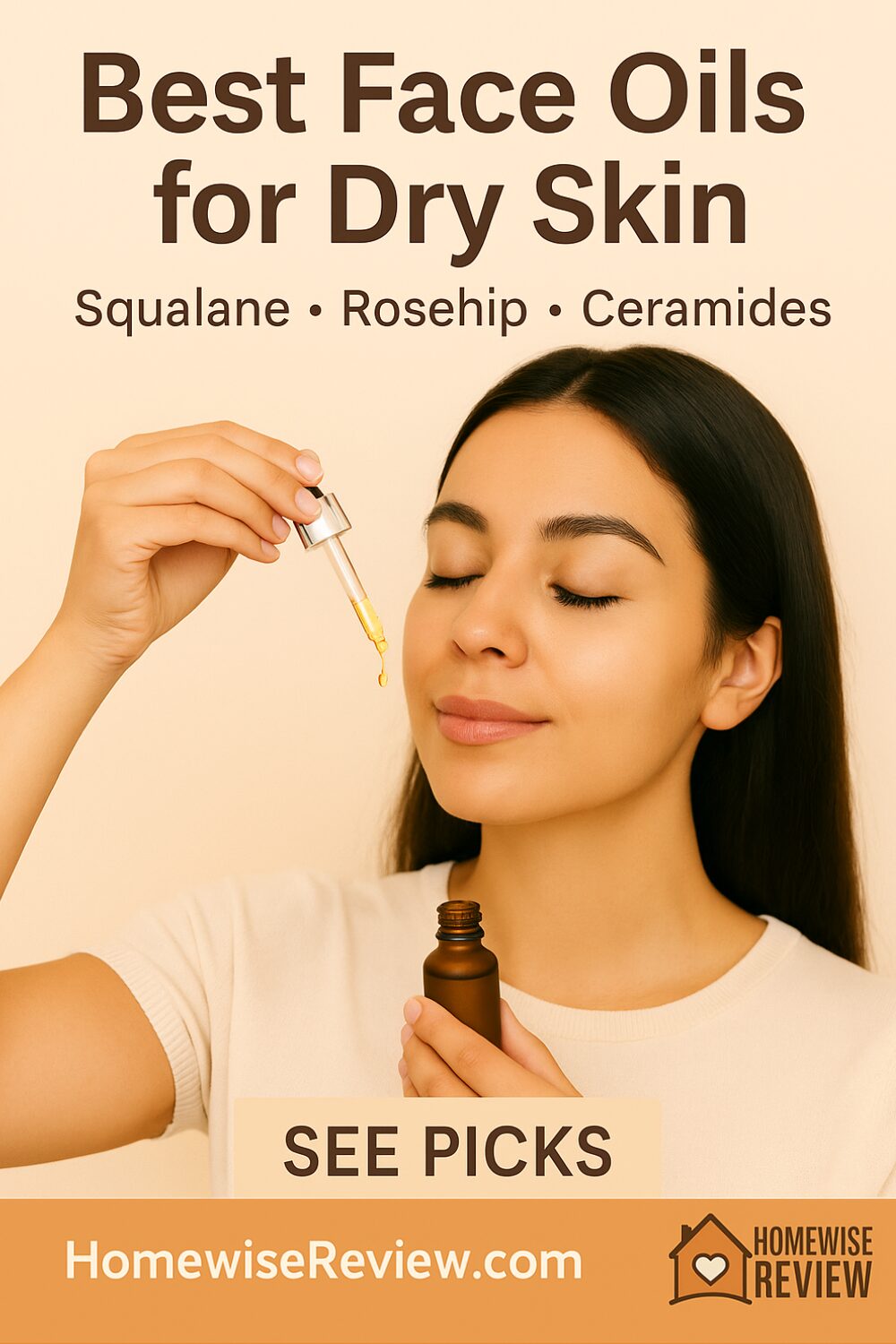
When your moisturizer stops cutting it, a good face oil can be the missing last step. Dry skin often lacks lipids in the outer layer, so water escapes fast and texture looks dull. The right oil blend replaces those lipids, slows moisture loss, and smooths over rough patches so makeup sits better.
Not all oils behave the same. Lightweight squalane mimics skin’s natural sebum and sinks in fast. Rosehip brings fatty acids and a subtle brightening effect. Chia, jojoba, and marula feel richer and cushiony for winter nights. The four picks below balance nourishment with skin comfort, so you wake up soft rather than greasy.
Quick Picks
| Product | Key oils & actives | Feel | Best for |
|---|---|---|---|
| Biossance Squalane + Vitamin C Rose Oil | Sugar-cane squalane, oil-soluble vitamin C, rose | Lightweight, silky | Dull, dry skin that wants glow and bounce |
| Kiehl’s Midnight Recovery Concentrate | Squalane, evening primrose, lavender | Cushiony, overnight | Parched skin that loves an overnight drink |
| The Ordinary 100% Organic Rose Hip Seed Oil | Pure cold-pressed rosehip | Medium, non-sticky | Budget brightening and barrier support |
| CeraVe Skin Renewing Gel Oil | Ceramides, squalane, sunflower, “CeraPlex” | Gel-to-oil, fast-absorbing | Sensitive, barrier-fragile skin that wants simple comfort |
Deep Dives
Biossance Squalane + Vitamin C Rose Oil — Glow without the grease
Rating: 4.8/5
Why it works for dry skin: Sugar-cane squalane mimics skin’s own oils, so it absorbs quickly while boosting softness. The oil-soluble vitamin C derivative adds a subtle brightening effect that owners say helps with overall radiance over a few weeks. Reviewers with tight, flaky cheeks like that it feels silky, not heavy, and layers well over gel or cream moisturizers.
Best for: Normal-to-dry and dry skin that wants glow plus cushion without a slick film.
How to use: 2–3 drops pressed over moisturizer morning or night. Plays nicely under sunscreen and makeup.
Pros: Silky texture, visible glow, fragrance is soft.
Cons: Premium price.
Kiehl’s Midnight Recovery Concentrate — The classic overnight comfort oil
Rating: 4.7/5
Why it works for dry skin: A mix of squalane and evening primrose gives a plush, occlusive layer that helps your night cream lock in water. Many owners wake up with smoother cheeks and less tightness around the mouth. The lavender scent is relaxing for some users at bedtime.
Best for: Very dry or seasonally dehydrated skin that wants a richer night finish.
How to use: 2–4 drops over your PM moisturizer. Warm in palms and press, do not rub.
Pros: Cushiony, overnight softening, a little goes far.
Cons: Scented. If fragrance is not your thing, consider The Ordinary or CeraVe.
The Ordinary 100% Organic Cold-Pressed Rose Hip Seed Oil — Affordable, effective
Rating: 4.6/5
Why it works for dry skin: Rosehip provides linoleic and linolenic acids to support a calm, flexible barrier, plus a natural carotenoid tint that can make skin look slightly brighter. Owners like the value and the way a few drops reduce flakiness around the nose and forehead.
Best for: Budget friendly barrier support and a soft brightening effect.
How to use: At night, 2–3 drops after moisturizer. If you are prone to congestion, start every other night.
Pros: Single-ingredient, wallet friendly, great for slugging alternatives.
Cons: Earthy scent, can feel a bit heavier than squalane.
CeraVe Skin Renewing Gel Oil — Barrier-first comfort for sensitive skin
Rating: 4.5/5
Why it works for dry skin: A gel-to-oil texture with ceramides, squalane, and sunflower oil aims squarely at barrier repair. Owners with easily irritated skin report less stinging than with many fragranced blends, and the finish is dewy rather than greasy.
Best for: Sensitive, barrier-fragile, or retinol-using skin that needs simple comfort.
How to use: 1–2 pumps after moisturizer morning or night. Great as a winter AM finisher under sunscreen.
Pros: Fragrance-free, ceramide support, fast to apply.
Cons: Less “luxury glow” feel than premium blends.
How to layer face oils for maximum hydration
- Moisturizer first, oil last. Oils seal water in. Apply your hydrating serum and moisturizer, then press oil on top.
- Use drops, not droppers. 2–3 drops is usually enough for the entire face. More can overwhelm makeup.
- Target dry zones. If your T-zone is normal, spot-treat cheeks and sides of the mouth.
- AM vs PM. Daytime, choose faster-absorbing squalane blends. Nighttime, go richer with rosehip or primrose.
- Makeup tip. Mix a tiny drop into foundation to reduce cling on flakes, or press a drop over makeup on the high points for a healthy sheen.
See also
If you are rebuilding a dry, tight barrier, begin with Best Face Cleansers for Dry Skin for a gentle, non-stripping wash, then follow with a hydrating pick from Best Hydrating Toners for Dry Skin so your oil has water to seal in. For an everyday cream under your oil, see Best Moisturizer for Dry Skin and rotate in a calm, fragrance-free option when your skin is reactive.
If brightening is a goal, pair your oil with a serum from Best Vitamin C Serums in the morning and keep irritation low by using gentle polishers from Best Exfoliators for Sensitive Skin once or twice weekly. When you want a retinoid routine that still stays soft, start with Best Retinol Creams for Beginners and finish with a few drops of oil to cushion the edges.
Affiliate Disclosure
If you purchase through links on our site, we may earn a small commission at no extra cost to you.
FAQ
Can face oils replace moisturizer
Not usually. Moisturizers supply water and humectants, plus barrier helpers. Oils mostly seal moisture in. Use both for best results.
Which oil is least likely to clog pores
Squalane is generally well tolerated and lightweight. Jojoba is also friendly for many. Patch test if you are prone to congestion.
Can I use oil in the morning under sunscreen
Yes. Choose lighter textures like squalane, allow a few minutes to settle, then apply sunscreen. Blot excess before makeup.
Are essential oils safe on dry skin
Some blends include fragrant oils that can irritate sensitive skin. If you are reactive, pick fragrance-free or stick to single-ingredient oils.
How much should I use
Start with 2–3 drops. Press into damp skin over moisturizer. Add one more drop only if you still feel tight after a few minutes.




